
30
19
39
117
M20 drill out gland hole
for side cable entry
51
60
4.5mm Fixing Holes
M20 Drill out gland hole
for rear cable entry
97.5
102
Sonos Pulse Sounder Beacon - Wall/Mur
Instruction Manual
Sonos Pulse Sounder Beacon - Wall
Sonos Pulse Sounder Beacon - Ceiling
EN FR DE NL ES PT IT PL SE DK
MADE IN ENGLAND INS586-3
Fire Alarm Device: Sounder Beacon.
Type A: For indoor use (Shallow Base & Deep Base)
Technical Datatsheet ATS00004
7.5m
7.5m
2.4m
Shallow Base/ Base courte
8.9m
103.5
100
14
94
51
60
Cable Entry
4.2 Fixing Holes
EN54-23 Coverage: W-2.4-7.5
EN54-23 Coverage: C-3-8.9
Deep Base/ Base profonde
Sonos Pulse Sounder Beacon - Ceiling/ Plafond Shallow Base/ Base courte
Essential Characteristics EN54-3:2001+A1:2002
A2:2006 Subclause
Reproducibility Pass
Operational performance Pass
Durability Pass
Temperature Resistance Pass
Humidity resistance Pass
Shock and vibration resistance Pass
Corrosion resistance Pass
Electrical stability Pass
Enclosure Protection Pass
Essential Characteristics EN54-23:2010 Subclause
Duration of operation Pass
Provision for external conductors Pass
Flammability of materials Pass
Enclosure protection Pass
Access Pass
Manufacturers adjustments Pass
On-site adjustment behaviour Pass
Requirements for software controlled devices Pass
Coverage volume Pass
Variation of light output Pass
Minimum and maximum light intensity Pass
Light Colour Red
Light temporal pattern and frequency of ashing Pass 0.5Hz/1Hz
Marking and data Pass
Synchronisation (Option with requirements) Pass
Durability Pass
Temperature Resistance Pass
Humidity resistance Pass
Shock and vibration resistance Pass
Corrosion resistance Pass
Electrical stability Pass
FR: Dispositif visuel d’alarme feu avec diuseur sonore d’alarme feu
Type A : pour une utilisation intérieure (bases profonde et courte).
Fiche technique ATS00004
M20
M4 M20
Deep Base/ Base profonde
Fig. 2
Fig. 1a
Fig. 2a Fig. 2b Fig. 2c
Fig. 1b
Head Type Coverage Volume CPR Number LPCB Number
ESFA2000R C-3-8.9 0832-CPR-F0147 717d/05
ESFA2000W C-3-8.9 0832-CPR-F0147 717d/06
ESFA1000R W-2.4-7.5 0832-CPR-F0149 717d/07
ESFA1000W W-2.4-7.5 0832-CPR-F0149 717d/08
If required, the mechanism for locking the sounder to the base
can be activated by removing the thin section of plastic shown
in Fig. 1a with side cutters or a similar tool. To open a locked
head, remove the small rubber bung from the hole on the side
of the sounder, insert a tool into the hole and depress the clip
whilst twisting the head. The O-ring and bung must be re-fitted
to maintain the weatherproofing.
An alternative locking method is shown in Fig. 1b. Drive the
hexagonal locking screw forward by turning a 1.5mm hexagonal
key clockwise until the head is locked.
Wiring
Line Terminal Marking
Common Positive Supply IN (3) IN+
Sounder Negative Supply (2) – or COM –
Beacon Negative Supply (1)
The sounder and beacon 0V terminals can be linked together for
simultaneous control of sound and light using a 2-core connection.
A separate earth terminal is provided on the deep base for connecting
the screen or functional earth. On the shallow base, terminal 5
can be used for this purpose.
Tone selection/Volume control/Flash rate
a. The device tone is set using switches 1-5 on the Tone Selector
DIP switch (see Figure 2a). See tone table for a complete list of
tone/DIP switch settings.
b. Switch 6 on the Tone Selector DIP switch is used to select the
sound volume (See Figure 2b). The default setting (switch OFF)
is high volume. Changing the switch to ON reduces the sound
output by 8dB.
c. Switch 7 Flash rate: 0.5Hz =OFF/1Hz =ON (See Figure 2c).
Technical Specification
EN: Installation Manual
Products marked with this symbol cannot be disposed of as
unsorted municipal waste in the European Union. For proper
recycling, return this product to your local supplier upon
the purchase of equivalent new equipment, or dispose of it
at designated collection points. For more information see:
www.recyclethis.info.
Supply Voltage Range 17- 60Vdc
Switch on Surge @
24Vdc
<1.2mA
Current:
Alarm (Sounder/
Beacon) @ 24Vdc 0.5Hz
25.1mA
Alarm (Sounder/
Beacon) @ 24Vdc 1Hz
45.1mA
Sounder:
Number of Tones 32
Peak Sound Level See datasheet
ATS00004
Frequency Range 400 - 2900 Hz
Beacon:
Flash Rate
Light Temporal
Pattern
• 55ms ON, 945mS OFF; frequency
ashing 1 second (1Hz)
• 55ms ON, 1945mS OFF; frequency
ashing 2 seconds (0.5Hz)
Flash Colour Red
Coverage (ceiling) C-3-8.9 (186.6m3)
Coverage (wall) W-2.4-7.5 (135m3)
Environmental:
Humidity 5% to 95%
Temperature -10°C to +55°C
Casing High Impact
Polycarbonate
IP Rating IP21C (shallow base)
IP33C (deep base) for EN54-3,EN54-23
installations with a cable gland (IP33C
minimum)
For other installations independently
tested to IP65 (IP65 is not valid on
EN54-3 or and EN54-23 installations).
Synchronisation Automatic
FR: Notice d’instructions
Pour activer le verrouillage de la sirène à sa base, il faut enlever
la fine plaque de plastique comme indiqué sur le dessin 1a avec
un cutter. Pour déverrouiller la base, enlever l’insert blanc situé
sur le côté, insérer un outil dans le trou pour appuyer sur le
verrou tout en faisant pivoter la sirène. Le joint torique et l’insert
doivent être replacé pour maintenir l’étanchéité.
Une autre méthode de blocage est indiquée à la gure 1b. Enler
la vis de blocage hexagonale en utilisant une clé hexagonale de
1.5 mm, et en la faisant tourner dans le sens des aiguilles d’une
montre jusqu’à ce que la tête soit bloquée.
Câblage
Alimentation Bornier
+ Alimentation (3) IN+
- Alimentation (0 Vcc) (2) – ou COM –
Feu à éclats- Alimentation (1)
Le commun (0 Volts) de la sirène et du feu à éclats peuvent être
interconnectés pour un déclenchement simultané par une seule
paire de fils.
Un terminal terre séparé est fourni sur la base profonde pour
connecter le câble ou terre fonctionnelle. Sur la base courte, le
terminal 5 peut être utilise a cet effet.
Sélection de tonalité/Contrôle du volume/
Fréquence de clignotement
a. Le son de l’appareil se règle à l’aide d’interrupteurs 1-5 du
commutateur DIP (voir figure 2a). Reportez-vous à la table
pour obtenir une liste complète des paramétrages du son/
commutateur DIP.
b. L’interrupteur 6, du commutateur de sélecteur de sons DIP,
permet de sélectionner le volume du son (voir figure 2b).
Le réglage par défaut (hors circuit) correspond à un volume
important. Positionnez l’interrupteur sur ON pour réduire la
sortie du son à 8dB. La fonction supplémentaire de réduction
du volume du son (8dB) par interrupteur n’est pas conforme a
la norme NF-508.
c. L’interrupteur 7 Fréquence de clignotement: 0.5Hz =OFF/
1Hz =ON (voir figure 2c).
Tension admissible 17- 60Vdc
Switch on Surge @ 24Vdc <1.2mA
Courant:
Alarme (Sirène/Feu à éclats) @
24Vdc 0.5Hz
25.1mA
Alarme (Sirène/Feu à éclats) @
24Vdc 1Hz
45.1mA
Sirène:
Nombre de sons 32
Puissance sonore maximum Voir che technique ATS00004
Gamme de fréquence 400 - 2900 Hz
Feu à éclats:
Fréquence de clignotement
Durée de l’impulsion
lumineuse
• 55ms ON, 945mS OFF; fréquence
du clignotement 1 seconde (1Hz)
• 55ms ON, 1945mS OFF;
fréquence du clignotement 2
secondes (0.5Hz)
Couleur du ash Rouge
Couverture (plafond) C-3-8.9 (186.6m3)
Couverture (muraux) W-2.4-7.5 (135m3)
Environnementale:
Hygrométrique 5% to 95%
Température -10°C to +55°C
Matière Polycarbonate résistant au choc
Degré d’étanchéité IP21C (base courte)
IP33C (base profonde) pour les
installations EN54-3, EN54-23
avec presse-étoupe (IP33C
minimum).
Testé indépendamment à
IP65 pour toutes autres types
d’installation (IP65 non valide
sur les installations EN54-3 et
EN54-23).
Synchronisation Automatique
Les produits marqués de ce symbole peuvent pas être éliminés
comme déchets municipaux non triés dans l’Union européenne. Pour
le recyclage, retourner ce produit à votre fournisseur au moment de
l’achat d’un nouvel équipement équivalent, ou à des points de collecte
désignés. Pour plus d’informations, voir: www.recyclethis.info.
EN54-3 Certied Type A tones 1,2,3,6,7 and 13. NF Certication only valid for
tone No.6. (NF-Système de sécurité incendie - www.marque-nf.com)
EN54-3 Certifié Type A pour les tons 1, 2, 3, 6, 7 et 13.
Certification NF valable pour le son 6 uniquement. (NF-Système de sécurité
incendie - www.marque-nf.com)
Certification NF
Seules les modèles avec une des références commerciales
suivantes sur leur tête et ayant l’estampille NF sont certifiées NF:
Conditions spéciales pour une utilisation avec un système NF-SSI:
No identification NF-SSI Référence commerciale
(Head Type)
Description
DS 044 F ESFA2000R C-3-8.9 Corps rouge
DS 044 E ESFA2000W C-3-8.9 Corps blanc
DS 044 H ESFA1000R W-2.4-7.5 Corps rouge
DS 044 G ESFA1000W W-2.4-7.5 Corps blanc
1. Certification NF pour le son 6 seulement (AFNOR NF S32-001)
2. Contrôle du volume non disponible
3. La tête doit être verrouillée à la base comme indiqué dans
Fig1a.
Spécification technique
14
100
51
60
Cable Entry
4.2 Fixing Holes
100
EN: Ensure the lens of the device is pointing to the oor.
FR: Assurez-vous que la lentille est dirigée vers le sol.
M4
19
39
122
M20 Drill out
gland hole for
side cable entry
51
60
30
4.5mm Fixing Holes
M20 Drill out
gland hole for
rear cable entry
97.5
EN: Ensure the lens of the device is pointing to the oor.
FR: Assurez-vous que la lentille est dirigée vers le sol.
M4
M20
0832
13 717d M4
TONE TONE TYPE TONE DESCRIPTION/APPLICATION DIP SWITCH
1-2-3-4-5
1. 970Hz O-O-O-O-O
2. 800Hz/970Hz @ 2Hz O-O-O-O-I
3. 800Hz – 970Hz @ 1Hz O-O-O-I-O
4. 970Hz 1s OFF/1s ON O-O-O-I-I
5. 970Hz, 0.5s/ 630Hz, 0.5s O-O-I-O-O
6. 554Hz, 0.1s/ 440Hz, 0.4s (AFNOR NF S 32 001 ) O-O-I-O-I
7. 500 – 1200Hz, 3.5s/ 0.5s OFF (NEN 2575:2000 Dutch Slow Whoop) O-O-I-I-O
8. 420Hz 0.6s ON/0.6s OFF (Australia AS1670 Alert tone) O-O-I-I-I
9. 1000 - 2500Hz, 0.5s/ 0.5s OFF x 3/1.5s OFF ( AS1670 Evacuation) O-I-O-O-O
10. 550Hz/440Hz @ 0.5Hz O-I-O-O-I
11. 970Hz, 0.5s ON/0.5s OFF x 3/ 1.5s OFF (ISO 8201 ) O-I-O-I-O
12. 2850Hz, 0.5s ON/0.5s OFF x 3/1.5s OFF (ISO 8201) O-I-O-I-I
13. 1200Hz – 500Hz @ 1Hz (DIN 33 404) O-I-I-O-O
14. 400Hz O-I-I-O-I
15. 550Hz, 0.7s/1000Hz, 0.33s O-I-I-I-O
16. 1500Hz – 2700Hz @ 3Hz O-I-I-I-I
17. 750Hz I-O-O-O-O
18. 2400Hz I-O-O-O-I
19. 660Hz I-O-O-I-O
20. 660Hz 1.8s ON/1.8s OFF I-O-O-I-I
21. 660Hz 0.15s ON/0.15s OFF I-O-I-O-O
22. 510Hz, 0.25s/ 610Hz, 0.25s I-O-I-O-I
23. 800/1000Hz 0.5s each (1Hz) I-O-I-I-O
24. 250Hz – 1200Hz @ 12Hz I-O-I-I-I
25. 500Hz – 1200Hz @ 0.33Hz I-I-O-O-O
26. 2400Hz – 2900Hz @ 9Hz I-I-O-O-I
27. 2400Hz – 2900Hz @ 3Hz I-I-O-I-O
28. 500 - 1200Hz, 0.5s/ 0.5s OFF x 3/1.5s OFF ( AS1670 Evacuation) I-I-O-I-I
29. 800Hz – 970Hz @ 9Hz I-I-I-O-O
30. 800Hz – 970Hz @ 3Hz I-I-I-O-I
31. 800Hz, 0.25s ON/1s OFF I-I-I-I-O
32. 500Hz – 1200Hz, 3.75s/0.25s OFF (AS2220) I-I-I-I-I
Klaxon Signals is a division of Texecom Ltd. © 2013 St. Crispin Way, Haslingden, BB4 4PW Tel: +44 1706 234800
Email: [email protected] www.klaxonsignals.com Pulse Alert is a trademark of Texecom Ltd.

INS586-3
Indien nodig kan het mechanisme om het alarm aan de basis
tevergrendelen worden geactiveerd door het verwijderen
van het dunne stukje plastic met een tang of vergelijkbaar
gereedschap zoals aangegeven in Fig. 1a. Om een vergrendelde
kop te openen: verwijder de kleine witte stop uit het gat aan
de zijkant van het alarm, steek een schroevendraaier o.i.d. in
het gat en druk het lipje in terwijl u de kop draait. De o-ring en
de stop moeten worden teruggeplaatst om de waterdichtheid
te behouden.
In Fig. 1b wordt een alternatieve vergrendelingsmethode
getoond. Draai de zeskantborgschroef met een 1.5 mm
zeskantsleutel naar rechts tot de kop is vergrendeld.
Bedrading
Lijn Contact markering
Common Gewone positieve voeding IN (3) IN+
Negatieve voeding alarm (2) – or COM –
Negatieve voeding waarschuwingsbaken (1)
De 0 V contacten van het alarm en het baken kunnen aan elkaar
worden gekoppeld voor simultane bediening van geluid en licht
met een twee-aderige aansluiting.
NL: Montageinstructies
Producten met deze label mogen niet verwijdert worden via de
gemeentelijke huisvuilscheiding in de Europese Gemeenschap.
Voor correcte vorm van kringloop, geef je de producten terug aan
jou locale leverancier tijdens het aankopen van een gelijkaardige
nieuw toestel, of geef het af aan een gespecialiseerde verzamelpunt.
Meer informatie vindt u op de volgende website: www.recyclethis.info.
Spanningsbereik 17- 60Vdc
Piek bij inschakelen @
24Vdc
<1.2mA
Stroomsterkte:
Alarm (Sirene/Flitslicht) @
24Vdc 0.5Hz
25.1mA
Alarm (Sirene/Flitslicht) @
24Vdc 1Hz
45.1mA
Sirene:
Aantal beschikbare tonen 32
Hoogste geluidsniveau Zie datasheet ATS00004
Frequentiebereik 400 - 2900 Hz
Flitslicht:
Flitssnelheid 0.5Hz/1Hz
Flash Kleur Rood
Dekkingsgebied
(plafond)
C-3-8.9 (186.6m3)
Dekkingsgebied (wand) W-2.4-7.5 (135m3)
Milieu-:
Relatieve vochtigheid 5% tot 95%
Gebruikstemperatuur -10°C tot +55°C
Behuizing Slagvast polycarbonaat
IP waarde IP21C (lage basis)
IP33C (diepe basis) voor EN54-3,
EN54-23 installaties met een
kabelbus (minimaal IP33C)
Voor andere installaties
onafhankelijk getest voor IP65
(IP65 geldt niet voor EN54-3 of
EN54-23 installaties).
Synchronisatie Automatisch
Door de EN54-3 gecerticeerd, alleen tonen 1,2,3,6,7 en 13.
DE: Installationsanweisung
Um den Signalgeber im Sockel zu arretieren, ist das
Sicherungsplättchen im Gehäuse zu entfernen. Dies kann
vorsichtig mit einem Seitenschneider oder ähnlichem Werkzeug,
wie in der Abb. 1a dargestellt, herausgelöst werden. Um einen
arretierten Signalgeberkopf aus dem Sockel zu entnehmen, ist
zunächst die weiße Schutzkappe am Kopf herauszuziehen und
durch die Öffnung, mit einem schmalen Schraubendreher, den
innen liegenden Verschlussbügel aus der Arretierungsposition
zu drücken. Um die Schutzklasse zu erhalten, ist die Schutzkappe
und der O-Ring wieder einzusetzen.
Abb. 1b zeigt eine alternative Verriegelungsmethode. Ziehen Sie
die Innensechskant-Feststellschraube durch Drehen eines 1.5
mm Sechskantschlüssels im Uhrzeigersinn fest.
Verdrahtung
Anschluss Klemme
Common Versorgung + (17 bis 60 V DC) (3) IN+
Versorgung – (0 V) (2) – ou COM –
Optisches Signal: Versorgung – (0 V) (1)
Die 0V Klemmen des akustischen und optischen Signals
sollten zusammengeführt werden, um beide Signale in einem
Zweileitersystem gemeinsam zu steuern.
Eine zusätzliche Klemme steht im PG-Sockel zur Verfügung,
um PE oder die Abschirmung auflegen zu können. Im flachen
Montagesockel kann Klemme 5 zu diesem Zweck genutzt
werden.
Tonauswahl/Lautstärkeregelung/Blitzrate
Der Alarmton des Geräts wird mit den Schaltern 1-5 am Tone
Selector DIP-Schalter eingestellt (siehe Abb. 2a). Eine Übersicht
über alle Toneinstellungen / DIP-Schaltereinstellungen finden
Sie in der Tabelle am Ende dieses Dokuments.
Schalter 6 amTone Selector DIP-Schalter dient zur Regelung der
Tonlautstärke (siehe Abb. 2b). Die Standardeinstellung (Schalter
AUS) ist hohe Lautstärke. Wird der Schalter auf EIN gestellt, so
wird die Tonausgabe um 8 dB verringert.
Schalten 7 Blitzrate: 0.5Hz =Aus/1Hz =Ein (Siehe Abb. 2c).
Technische Spezifikationen
Versorgungsspannung 17- 60Vdc
Einschaltspitze @ 24Vdc <1.2mA
Stromaufnahme:
Alarmsirene/optischer
Melder bei @ 24Vdc 0.5Hz
25.1mA
Alarmsirene/optischer
Melder bei 24Vdc 1Hz
45.1mA
Sounder:
Anzahl der Töne 32
Spitze Geräuschpegel Siehe Datenblatt ATS00004
Frequenzbereich 400 - 2900 Hz
Warnleuchte:
Blitzrate 0.5Hz/1Hz
Blitzfarbe Rot
Wirkbereich (höchst-
grenze)
C-3-8.9 (186.6m3)
Wirkbereich (wand) W-2.4-7.5 (135m3)
Environmental:
Relative Feuchte 5% bis 95%
Betriebstemperatur -10°C bis +55°C
Gehäuse Schlagbeständiges Polykarbonat
Schutzklasse IP21C (acher Sockel)
IP33C (tiefer Sockel) für EN54-3 und
EN54-23 Installationen mit einer
Kabelverschraubung (mindestens
IP33C)
Für sonstige, unabhängig gemäß
IP65 geprüfte Installationen (IP65
gilt nicht für EN54-3 und EN54-23
Installationen).
Synchronisation Automatisch
EN54-3 pour les tons 1, 2, 3, 6, 7 et 13.
Das Ziel der EG-Richtlinie über Elektro- und Elektronik-Altgeräte
ist, Umwelt- und Gesundheitsschäden durch Elektro- und
Elektronik-Altgeräte so gering wie möglich zu halten. Um diese
Richtlinie einzuhalten, dürfen Elektrogeräte, die mit diesem Symbol
gekennzeichnet sind, nicht in den öffentlichen europäischen
Entsorgungssystemen entsorgt werden. Europäische Benutzer von
Elektrogeräten müssen ab sofort Altgeräte zur Entsorgung zurückgeben.
Nähere Informationen hierzu finden Sie auf der folgenden Website:
www.recyclethis.info.
Op de hoge basis is een aparte aardaansluiting aanwezig voor
het aansluiten van het scherm of de aarde. Op de lage basis kan
uitgang 5 hiervoor gebruikt worden.
Toonselectie/Volumebediening/Flitssnelheid
a. Het geluidssignaal wordt ingesteld door middel van
dipschakelaars 1-5 op het toonschakelblok (zie afb. 2a). In de
tabel op het eind van dit document vindt u de volledige lijst van
toon- / dipschakelaarinstellingen.
b. Met dipschakelaar 6 op het toonschakelblok selecteert u het
geluidsvolume (zie afb. 2b). De fabrieksinstelling (schakelaar
op OFF) is Hoog volume. Door deze schakelaar op ON te zetten
wordt het geluidsvolume met 8dB verminderd.
c. Met dipschakelaar 7 Flitssnelheid: 0.5Hz =UIT/1Hz =OP (zie
afb. 2c).
Technische Specificaties
ES: Instrucciones de Instalación
Active el mecanismo de seguridad si esto fuera necesario, para
evitar que la sirena pueda ser desconectada de la base. Para hacer
esto, corte el cacho de plástico que le mostramos en la Fig. 1a.
Una sirena que haya sido bloqueada, solo se puede desbloquear
quitando el pequeño tapón situado en el lateral e insertando
una pequeña varilla para presionar el mecanismo de bloqueo.
Debemos asegurar que la arandela y el tapón están colocados
para asegurar la resistencia a intemperie.
La Fig. 1b muestra un método de sujeción alternativo. Mueva
el tornillo de sujeción hexagonal hacia delante girando la llave
hexagonal de 1.5 mm en sentido horario hasta que la cabeza
quede jada.
Cableado
Línea Terminal
Common Positivo IN (3) IN+
Consumo Negativo (2) – ou COM –
Conexión Negativo de la luz
de Xenón
(1)
Para un funcionamiento simultaneo de la luz de xenón y la
sirena en un sistema de dos cables, los terminales (0V) deben
estar unidos.
Se proporciona un terminal de tierra en la base profunda para
conectar el cable apantallado o funcional de tierra. En la base
superficial, el terminal 5 también se usa para esto.
Selección del tono/Control del volumen/
Frecuencia de destello
a. El tono del equipo se ajusta utilizando los conmutadores 1-5
del interruptor DIP de selección de tono (véase la figura 2a).
Véase en la tabla de tonos una lista completa de los ajustes de
tono/interruptor DIP.
b. El conmutador 6 del interruptor DIP de selección de tono se
utiliza para seleccionar el volumen del sonido (véase la figura
2b). El ajuste predeterminado (conmutador OFF) corresponde
a volumen alto. Si se cambia el conmutador a ON, la salida de
sonido se reduce 8 dB.
c. Conmutador 7 de frecuencia de destello: 0,5 Hz =OFF/ 1 Hz =ON
(véase la figura 2c).
Voltaje de Alimentación 17- 60Vdc
Encienda sobretensiones
@ 24Vdc
<1.2mA
Corriente
Alarma (Receptor acústico/
luz) @ 24Vdc 0.5Hz
25.1mA
Alarma (Receptor acústico/
luz) @ 24Vdc 1Hz
45.1mA
Receptor acústico:
Número de tonos 32
Nivel màximo de sonido Ver cha técnica ATS00004
Frecuencia 400 - 2900 Hz
Luz:
Número de Destellos 0.5Hz/1Hz
Flash de Color Rojo
Cobertura (techo) C-3-8.9 (186.6m3)
Cobertura (pared) W-2.4-7.5 (135m3)
Medioambiental:
Humedad 5% a 95%
Temperatura -10°C a +55°C
Carcasa Policarbonato
Resistente al Fuego
Clasicación IP IP21C (base supercial)
IP33C (base profunda) para
instalaciones EN54-3, EN54-23 con
prensaestopas (mínimo IP33C).
Para otras instalaciones, probado
independientemente para IP65 (IP65
no es válido en instalaciones EN54-3
o EN54-23).
Sincronización Automática
EN54-3 accreditado solamente tonos 1,2,3,6,7 & 13.
Especificaciones Técnicas
PT: Manual de Instalação
Se necessário, o mecanismo para fixar o sensor à base pode ser
activado removendo a fina película de plástico ilustrada na Fig.
1a com um alicate de corte ou uma ferramenta semelhante. Para
abrir uma cabeça bloqueada, retire o pequeno tampão branco do
orifício existente na parte lateral do sensor, insira uma ferramenta
no orifício e carregue na mola enquanto roda a cabeça. O O-ring
e o tampão devem ser reinstalados no intuito de manter a
estanquicidade às intempéries.
Na Fig. 1b é apresentado um método de bloqueio alternativo.
Avance o parafuso de bloqueio hexagonal ao rodar uma chave
hexagonal de 1.5 mm no sentido dos ponteiros do relógio até ao
bloqueio da cabeça.
Cablagem
linha Marcação Terminal
Alimentação positiva comum IN (3) IN+
Alimentação negativa do sensor (2) – or COM –
Alimentação negativa do farolim rotativo (1)
Os terminais 0V do sensor e do farolim rotativo
podem ser interligados para um controlo simultâneo do som e
da luz, utilizando uma ligação de 2 núcleos.
É fornecido um terminal terra independente na base profunda
para ligar o ecrã ou a terra funcional. Na base côncava, pode
utilizar-se o terminal 5 para este fim.
Seleção do tom/Vcontrole do volume/Alimentação
a. O tom do dispositivo é definido usando as chaves 1-5 do DIP
switch Seletor de Tons (veja a Figura 2a). Consulte a tabela no
fim deste documento para uma lista completa das definições de
tom/DIP switch.
b. A chave 6 do DIP switch Seletor de Tons é usada para selecionar
o volume do som (veja a Figura 2b). A definição padrão (chave
desligada – OFF) é volume alto. Ao mudar a chave para ligada
(ON) reduz o som em 8 dB.
c. Interruptor 7 Alimentação: 0.5Hz =OFF/1Hz =ON (veja a Figura 2c).
Especificações técnicas
Gama da tensão de
alimentação
17- 60Vdc
Surto de ligação @24Vdc <1.2mA
Corrent:
Alarme (Sonoro/lumi-
noso) @ 24Vdc 0.5Hz
25.1mA
Alarme (Sonoro/lumi-
noso) @ 24Vdc 1Hz
45.1mA
Sonoro:
Número de mensagens
sonoras
32
Nível sonoro de pico veja folha de dados ATS00004
Gama de frequência 400 - 2900 Hz
Luminoso:
Alimentação 0.5Hz/1Hz
Flash de cor Vermelho
Cobertura (teto) C-3-8.9 (186.6m3)
Cobertura (parede) W-2.4-7.5 (135m3)
Ambiental:
Umidade relativa 5% a 95%
Temperatura -10°C a +55°C
Caixa Policarbonato de alto impacto
Classe de protecção IP21C (base côncava)
IP33C (base profunda) para instalações
EN54-3, EN54-23 com boquilha de
cablagem (mínimo IP33C) Para outras
instalações testadas individualmente para
IP65 (IP65 não é válido em instalações
EN54-3 e EN54-23).
Sincronização Automático
Certicado apenas nos tons 1,2,3,6,7 e 13
IT: Istruzioni di installazione
Se necessario, è possibile attivare il meccanismo di bloccaggio
del segnalatore luminoso alla base rimuovendo la sottile
linguetta di plastica illustrata nella Fig. 1a con un tronchesino
o un attrezzo simile. Per aprire una testina bloccata, rimuovere
il piccolo tappo bianco dal foro laterale del segnalatore acustico,
inserire un attrezzo nel foro e premere il fermo svitando la testina.
La guarnizione ad anello e il tappo devono essere riposizionati
per mantenere la resistenza alle intemperie.
La Fig. 1b mostra un metodo di bloccaggio alternativo. Serrare la
vite di bloccaggio esagonale ruotando una chiave esagonale da
1.5 mm no al bloccaggio della testa.
Cablaggio
Linea Contrassegno sui terminali
IN alimentazione positiva comune (3) IN+
Alimentazione negativa
segnalatore acustico
(2) – or COM –
Alimentazione negativa
segnalatore luminoso
(1)
È possibile collegare tra loro i terminali 0V del segnalatore
acustico e del segnalatore luminoso per il controllo simultaneo
del suono e della luce usando un collegamento a due fili.
La base profonda è dotata di un terminale di terra separato per il
collegamento dello schermo o della terra funzionale. Sulla base
superficiale, allo stesso scopo è possibile usare il terminale 5.
Scelta del tono/Controllo volume/Velocità del flash
a. Il tono del dispositivo viene impostato per mezzo degli
interruttori 1-5 sul selettore a dip-switch dei toni (vedere figura
2a). Per un elenco completo dei valori d’impostazione dei toni
/ dip-switch, vedere la tabella al termine di questo documento.
b. L’interruttore 6 sul dip-switch del selettore toni viene usato
per impostare
il volume sonoro (vedere figura 2b). Il valore pre-impostato
(interruttore OFF) è volume alto. Spostando l’interruttore su ON
si riduce l’emissione sonora di 8 dB.
c. Interruttore 7 Velocità del flash: 0.5Hz =Spento/1Hz =Acceso
(vedere figura 2c).
Specifiche tecniche
I prodotti contrassegnati con questo simbolo, non possono essere
smaltiti nei comuni contenitori per lo smaltimento rifiuti, nell’Unione
Europea. Per il loro corretto smaltimento, potete restituirli al vostro
fornitore locale a seguito dell’acquisto di un prodotto nuovo
equivalente, oppure rivolgervi e consegnarli presso i centri di
raccolta preposti. Per maggiori informazioni vedere: ww.recyclethis.info.
Gamma tensione di alimen-
tazione
17- 60Vdc
Sovracorrente all’accensione
@ 24Vdc
<1.2mA
Corrente:
Allarme (Sirena/lampeggiante)
@ 24Vdc 0.5Hz
25.1mA
Allarme (Sirena/lampeggiante)
@ 24Vdc 1Hz
45.1mA
Sirena:
Numero di toni 32
Livello sonoro massimo vedi scheda
ATS00004
Campo di frequenza 400 - 2900 Hz
Lampeggiante:
Velocità del ash 0.5Hz/1Hz
Flash di colore Rosso
Copertura (sotto) C-3-8.9 (186.6m3)
Copertura (muro) W-2.4-7.5 (135m3)
Ambientale:
Umidità relativa 5% a 95%
Temperatura -10°C a +55°C
Alloggiamento Policarbonato ad alto impatto
Classe di IP IP21C (base superciale)
IP33C (base profonda) per
installazioni EN54-3 e EN54-23
con passacavo (minimo IP33C)
Per altre installazioni testate in
modo indipendente per IP65
(IP65 non è valida per le instal-
lazioni EN54-3 e EN54-23).
Sincronizzazione Automatica
Certicazione EN54-3 solo sui toni 1,2,3,6,7 e 13.
PL: Instrukcja montażu
W razie potrzeby mechanizm blokujący głośnik na podstawie
można uruchomić, usuwając cienką warstwę folii pokazaną
na Rys. 1a za pomocą szczypiec lub podobnego narzędzia.
Aby otworzyć zablokowaną głowicę, należy usunąć małe, białe
zamknięcie z otworu bocznego głośnika i za pomocą narzędzia
umieszczonego w otworze nacisnąć zatrzask jednocześnie
przekręcając głowicę. Pierścień „O” i zamknięcie muszą zostać
założone ponownie, aby zapewnić zabezpieczenie przed warunk-
ami pogodowymi.
Inną metodę blokowania przedstawiono na rysunku 1b. Obróć
w prawo sześciokątną śrubę blokującą za pomocą klucza
sześciokątnego 1.5 mm aż do zablokowania głowicy.
Okablowanie
Linia Listwa zaciskowa
Dodatnie, normalne zasilanie
wejściowe IN
(3) IN+
Ujemne zasilanie głośnika (2) – or COM –
Ujemne zasilanie
sygnalizatora
(1)
W Unii Europejskiej produkty oznaczone tym symbolem mogą
być usuwane tylko jako posegregowane odpady komunalne. Dla
zapewnienia właściwej utylizacji, należy zwrócić ten produkt do
dostawcy przy zakupie ekwiwalentnego, nowego urządzenia albo
dostarczyć go do wyznaczonego punktu zbiórki. Więcej informacji
można znaleźć na stronie internetowej www.recyclethis.info.
Zakres napięcia 17- 60Vdc
Prąd udarowy przy włączeniu
@ 24Vdc
<1.2mA
Prąd:
Alarm (sygnalizator akustyczny/
sygnalizator optyczny) @ 24Vdc
0.5Hz
25.1mA
Alarm (sygnalizator akustyczny/syg-
nalizator optyczny) @ 24Vdc 1Hz
45.1mA
Sygnalizator akustyczny:
Liczba sygnałów 32
Punkt najwyższej głośności Zobacz arkusz
ATS00004
Zakres częstotliwości 400 - 2900 Hz
Sygnalizator optyczny:
Częstotliwość migania 0.5Hz/1Hz
Flash Kolor Czerwony
Pokrycie (sut) C-3-8.9 (186.6m3)
Pokrycie (wall) W-2.4-7.5 (135m3)
środowiskowy:
Wilgotność względna 5% do 95%
Temperatura -10°C do +55°C
Obudowa Wytrzymałego
poliwęglanu
Oznaczenie IP IP21C (płytka podstawa)
IP33C (głęboka podstawa)
w przypadku instalacji
EN54-3, EN54-23 z dławnicą
kablową (minimum IP33C)
W przypadku innych
instalacji testowanych
niezależnie pod kątem IP65
(IP65 nie obowiązuje w
przypadku instalacji EN54-3
i EN54-23).
Synchronizacja Automatyczna
Gwarantowane wyłącznie w przypadku tonów 1, 2, 3, 6, 7 i 13
Końcówki 0V głośnika i sygnalizatora mogą zostać połączone w
celu jednoczesnego sterowania dźwiękiem i światłem za pomocą
połączenia 2-rdzeniowego.
W głębokiej podstawie dostępna jest oddzielna listwa zaciskowa
dla podłączenia ekranu lub zera roboczego. W przypadku płytkiej
podstawy do tego celu służy zacisk 5.
Wybór sygnału/kontrola głośności/
Częstotliwość migania
a. Sygnał urządzenia można ustawić korzystając z przełączników
1- 5 na mikroprzełączniku DIP selektora sygnałów (patrz rysunek
2a). Tabela znajdującą się na końcu niniejszego dokumentu
zawiera pełną listę sygnałów/ustawień mikroprzełącznika DIP.
b. Przełącznik 6 na mikroprzełączniku DIP selektora sygnałów
służy do wyboru głośności dźwięku (patrz rysunek 2b).
Ustawienia domyślne (WYŁĄCZENIE) to punkt wysokiej głośności
dźwięku. Zmiana przełącznika na tryb WŁĄCZONY zmniejsza
wyjście akustyczne o 8dB.
c. Przełącznik 7 Częstotliwość migania: 0.5Hz =Poza/1Hz =Na
(Rys. 2c).
Dane techniczne
SE: Installationsmanual
DK: Installationsanvisninger
Om så behövs, kan mekanismen för att låsa summern vid basen
aktiveras genom att avlägsna den tunna plastbiten, såsom visas
i Fig. 1a, med en sidavbitare eller liknande. För att öppna ett låst
huvud, avlägsna den lilla vita proppen från hålet på sidan av
summern, för in ett verktyg i hålet och tryck ned klämman medan
huvudet vrids. O-ringen och proppen måste sättas tillbaka för att
bibehålla väderskyddet.
En alternativ låsmetod visas i Fig. 1b. Driv den sexkantiga
låsskruven framåt genom att vrida en 1.5 mm insexnyckel
medsols tills huvudet är låst.
Koppling
Lina Klämma
Gemensamt positivt nät (3) IN+
Summer negativt nätgativ nät (2) – eller COM –
Blinkljus negativt nät (1)
Summerns och blinkljusets utklämmor kan sammankopplas
för samtidig reglering av ljud och ljus med användning av en
tvåådrig anslutning.
En separat jordklämma finns på den djupa basen för att anslutas
till skärmen eller funktionsjord. På den låga basen, kan klämma 5
användas för detta ändamål.
Tonval/volyminställning/blinkningshastighet
a. Enhetens ton väljs med omkopplare 1–5 på DIP-omkopplaren
för tonval (se Figur 2a). I tontabellen finns en komplett lista över
alla ton-/DIP-omkopplarinställningar.
b. Omkopplare 6 på DIP-omkopplaren för tonval används för att
ange ljudvolym (se Figur 2b). Standardinställning (AV) är hög
volym. Om du sätter omkopplaren på PÅ minskas den utgående
volymen med 8 dB.
c. Omkopplare 7 Blinkningshastighet: 0,5 Hz = OFF/1Hz = ON
(se Figur 2c).
Matningsspänningsområde 17- 60Vdc
Slå på Surge @ 24Vdc <1.2mA
Ström:
Alarm (Sounder/Blinkljus) @
24Vdc 0.5Hz
25.1mA
Alarm (Sounder/Blinkljus)
@ 24Vdc 1Hz
45.1mA
Aktuel:
Antal toner 32
Toppljudnivå Se datablad
ATS00004
Frekvensområde 400 - 2900 Hz
Blinkljus:
Blinkhastighet 0.5Hz/1Hz
Flash Färg Röd
Täckning (tak) C-3-8.9 (186.6m3)
Täckning (vägg) W-2.4-7.5 (135m3)
Miljö:
Luftfuktighet 5% a 95%
Arbetstemperatur -10°C to +55°C
Hus Hus av extra slagtåligt
polykarbonat
IP-värde IP21C (grund bas)
IP33C (djup bas) för
installationerna EN54-3, EN54-23
med en kabelpackbox (minimalt
IP33C)
För övriga installationer som
fristående testats enligt IP65 (IP65
är inte giltig på installationerna
EN54-3 och/eller EN54-23).
Synkronisering Automatisk
Enbart kalibrerad för toner 1,2,3,6,7 & 13
Om nødvendigt kan mekanismen for aflåsning af lyd alarmen
til underlaget aktiveres ved at fjerne det tynde plastik lag,
som vist på fig. 1a; dette kan gøres med sideskærere eller et
lignende værktøj. For at åbne et låst hoved, fjern den lille hvide
spunstap fra hullet på lyd alarmens side, og sæt et værktøj ind
i hullet og tryk klemmen ned mens hovedet drejes. O-ringen
og spunstappen skal genmonteres for at bevare vejrtætningen.
En alternativ låsemetode er vist i Fig. 1b. Før den sekskantede
låseskrue fremad ved at dreje en 1.5mm sekskantet indstiksnøgle
med uret, indtil hovedet er låst fast.
Trådføring
Ledning Klemme Marking
Almindelig positiv strømforsyning IN (3) IN+
Lyd alarmens negative strømforsyning (2) – elle COM –
Blinklys negativ strømforsyning (1)
Lyd alarmens og blinklysets 0V klemmer kan sammenkobles for
sideløbende kontrol af lyd og lys med en totrådet forbindelse.
Der findes en separat jordklemme på det dybe underlag for tilslutning
af skærmen eller den funktionelle jordklemme. På det flade underlag,
kan klemme 5 bruges til dette formål.
Tonevalg/lydstyrkeregulering/blinkhastighed
a. Enhedens tone indstilles ved hjælp af knapperne 1-5 på DIP-
kontakten til tonevalg (se figur 2a). Se en komplet liste med
toner/DIP-kontaktindstillinger i tonetabellen.
b. Knap 6 på DIP-kontakten til tonevalg bruges til at vælge
lydstyrke (se figur 2b). Standardindstillingen (kontakten på
OFF) er høj lydstyrke. Hvis du skifter til stillingen ON, reducerer
lydstyrken med 8 dB.
c. Knap 7 Blinkhastighed: 0,5 Hz = OFF/1 Hz = ON (se figur 2c).
Teknisk specifikation
Strømforsyningens
spændingsområde
17- 60Vdc
Tænd Surge @ 24Vdc <1.2mA
Strøm:
Alarm (Sounder/Blinklys) @
24Vdc 0.5Hz
25.1mA
Alarm (Sounder/Blinklys)
@ 24Vdc 1Hz
45.1mA
Aktuel lyd alarm:
Antal toner 32
Maksimalt lydniveau Se datablad
ATS00004
Frekvensområde 400 - 2900 Hz
Blinklys:
Blinkfrekvens 0.5Hz/1Hz
Blitz Farve Rød
Dækning (loft) C-3-8.9 (186.6m3)
Dækning (væg) W-2.4-7.5 (135m3)
Miljø:
Fugtighed 5% til 95%
Driftstemperatur -10°C til +55°C
Hus Slagfast hus af polykarbonat
IP kapacitet IP21C (smal sokkel)
IP33C (bred sokkel) til EN54-3,
EN54-23 installationer med en
kabelforskruning (minimum
IP33C)
Til andre installationer uafhængigt
afprøvet til IP65 (IP65 er ikke
gyldig på EN54-3 eller på EN54-23
installationer).
Synkronisering Automatisk
Kun certicerede toner 1,2,3,6,7 & 13
Teknisk specifikation
-
 1
1
-
 2
2
Klaxon Sonos Pulse Sounder Beacon Ceiling Instrucciones de operación
- Tipo
- Instrucciones de operación
- Este manual también es adecuado para
en otros idiomas
- français: Klaxon Sonos Pulse Sounder Beacon Ceiling Mode d'emploi
- italiano: Klaxon Sonos Pulse Sounder Beacon Ceiling Istruzioni per l'uso
- Deutsch: Klaxon Sonos Pulse Sounder Beacon Ceiling Bedienungsanleitung
- português: Klaxon Sonos Pulse Sounder Beacon Ceiling Instruções de operação
- dansk: Klaxon Sonos Pulse Sounder Beacon Ceiling Betjeningsvejledning
- polski: Klaxon Sonos Pulse Sounder Beacon Ceiling Instrukcja obsługi
Artículos relacionados
-
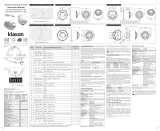 Klaxon Sonos Pulse Sounder Beacon Wall Instrucciones de operación
Klaxon Sonos Pulse Sounder Beacon Wall Instrucciones de operación
-
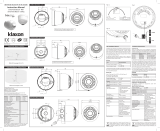 Klaxon Sonos Pulse Beacon Ceiling Instrucciones de operación
Klaxon Sonos Pulse Beacon Ceiling Instrucciones de operación
-
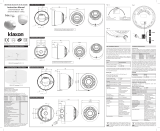 Klaxon Sonos Pulse Beacon Wall Instrucciones de operación
Klaxon Sonos Pulse Beacon Wall Instrucciones de operación
-
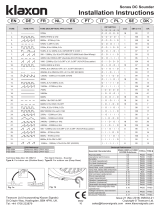 Klaxon Sonos Sounder Instrucciones de operación
Klaxon Sonos Sounder Instrucciones de operación
-
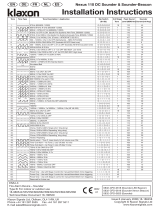 Klaxon 18-980664 Manual de usuario
Klaxon 18-980664 Manual de usuario
-
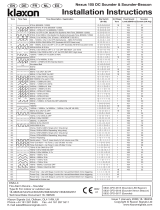 Klaxon Smoke Alarm 105 DC Manual de usuario
Klaxon Smoke Alarm 105 DC Manual de usuario
-
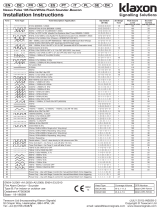 Klaxon Nexus Pulse 105 & 110 Instrucciones de operación
Klaxon Nexus Pulse 105 & 110 Instrucciones de operación
-
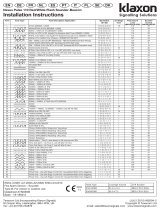 Klaxon Nexus Pulse 105 & 110 Instrucciones de operación
Klaxon Nexus Pulse 105 & 110 Instrucciones de operación
-
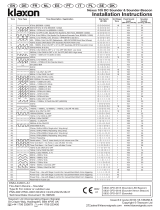 Klaxon Nexus 105/110/120 Sounder Instrucciones de operación
Klaxon Nexus 105/110/120 Sounder Instrucciones de operación
-
McQuay Smoke Alarm 110 AC Manual de usuario










